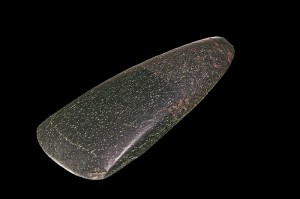Polished Axe

CC-BY-SA-3.0
Human hands have made and used ground stone axes and adzes in all parts of globe, beginning around 30,000 years ago. Whereas the chipped stone axe of the Palaeolithic is the quintessential tool of the hunter and meat eater, the ground stone axe or adze is the Swiss army knife of early cultivators. It can be employed to facilitate almost any task in the management, collection, cultivation and processing of plants – whether cereals, roots, shoots, nuts or fruits. Its enduring blade and versatility are what make it revolutionary. But it is not just a tool. With its polished sheen and complex stony textures it is also an aesthetic object, a thing of enchantment, of reverence, sometimes even awe.
Reading
Davies, V. and Edmonds, M. (eds). 2011.Stone Axe Studies III. Oxford: Oxbow Books (Contains latest info from Pierre Petrequin’ s work in Papua New Guinea on the manufacture of stone adzes– very accessible volume, well-illustrated and has a global approach)
Hardy, K. and Silitoe, P. 2003. Material Perspectives: Stone tool use and Material Culture in Papua New Guinea. Internet Archaeology, Vol. 14. http://intarch.ac.uk/journal/issue14/hardy_index.html See also: http://www.wolaland.org/page/Wola.php)
BBC History of the World in a 100 Objects – Jade axe http://www.bbc.co.uk/ahistoryoftheworld/objects/ZRfYPmVMSgmqZyFEY8VRJA
Edmonds, M. 1995.Stone Tools and Society: Working Stone in Neolithic and Bronze Age Britain. Routledge, UK. (Goes back to basics of manufacture and use, touches on ethnography)
